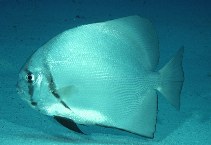| Family: |
Ephippidae (Spadefishes, batfishes and scats) |
| Max. size: |
45 cm TL (male/unsexed); max.weight: 800.0 g |
| Environment: |
reef-associated; marine; depth range 10 - 40 m |
| Distribution: |
Indo-Pacific: Indonesia to northwestern Australia. |
| Diagnosis: |
Dorsal spines (total): 9-9; Dorsal soft rays (total): 27-29; Anal spines: 3-3; Anal soft rays: 20-22. Silvery, with faint dark horizontal lines between scale rows. Brown band from top of head through eye to chest (fading with growth). Another, less distinct, curved dark bands from nape across operculum and pectoral-fin base to belly. Median fins dusky or pale with dark margins. Body orbicular and strongly compressed, its depth more than twice head length and 1.2 to 1.4 times in SL. Head length 3.1 to 3.6 times in SL. Head profile of adults with a slight bump between eyes. Snout, preopercle flange, and lower jaw naked, rest of head scaly. Jaws with 2 to 4 rows flattened, tricuspid teeth. Small patch of teeth on vomer. Palatines toothless. Five pores on each side of lower jaw. Preopercle with a few rudimentary serrae along its rounded angle. Opercle with a flat spine, and a rounded bone on its upper portion (Ref 43039). |
| Biology: |
Inhabits coastal reefs. Often occurs ion silt-sand bottoms of coastal trawling ground in 10-40 m (Ref. 90102). |
| IUCN Red List Status: |
Not Evaluated (N.E.) Ref. (130435)
|
| Threat to humans: |
harmless |
Source and more info: www.fishbase.org. For personal, classroom, and other internal use only. Not for publication.
